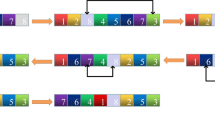Abstract
Matrix embedding (ME) can be exploited to improve the embedding efficiency for steganography by making fewer changes to the cover data. In ME, the sender and recipient agree on a parity check matrix (PCM) in advance. The PCM will be used by the sender to embed secret message into the cover data and later by the decoder to extract the embedded message. The embedding performance of ME is greatly influenced by the PCM thus the choice of PCM is crucial for ME. On the other hand, since larger sized PCM usually leads to higher embedding efficiency, how to keep the balance between the computational complexity and the embedding efficiency is also an important problem of ME. Based on these considerations, an efficient ternary ME method for large payloads data embedding is proposed in this paper. We utilize a specific matrix construction for PCM to improve embedding efficiency and a sub-optimal search strategy to reduce the computational complexity. The experimental results show that the proposed method achieves good embedding efficiency at low time cost and it outperforms some state-of-the-art works. For example, for a cover image with 512 × 512 pixels at an embedding rate of 1 bit per pixel, the proposed method can be implemented within 0.5 second in a personal computer with a rather high embedding efficiency as 3.89.







Similar content being viewed by others
References
Bierbrauer J, Fridrich J (2008) Constructing good covering codes for applications in steganography. In: Transactions on Data Hiding and Multimedia Security III, pp 1–22
Chao R, Wu H, Lee C, Chu Y (2009) A novel image data hiding scheme with diamond encoding. EURASIP J Inf Secur 2009(1):1–9
Crandall R (1998) Some notes on steganography. Steganography mailing list. http://dde.binghamton.edu/download/Crandall_matrix.pdf
Filler T, Judas J, Fridrich J (2011) Minimizing additive distortion in steganography using syndrome-trellis codes. IEEE Trans Inf Forensics Secur 6(3):920–935
Fridrich J, Goljan M, Lisonek P, Soukal D (2005) Writing on wet paper. IEEE Trans Signal Process 53(10):3923–3935
Fridrich J, Goljan M, Soukal D (2006) Wet paper codes with improved embedding efficiency. IEEE Trans Inf Forensics Secur 1(1):102–110
Fridrich J, Kodovský J (2012) Rich models for steganalysis of digital images. IEEE Trans Inf Forensics Secur 7(3):868–882
Fridrich J, Lisoněk P, Soukal D (2006) On steganographic embedding efficiency. In: Proceedings of the 8th international workshop on information hiding, pp 282–296
Fridrich J, Soukal D (2006) Matrix embedding for large payloads. IEEE Trans Inf Forensics Secur 1(3):390–395
Gao Y, Li X, Yang B (2009) Employing optimal matrix for efficient matrix embedding. In: Proceedings of the fifth international conference on intelligent information hiding and multimedia signal processing, pp 161–165
Gao Y, Li X, Zeng T, Yang B (2009) Improving embedding efficiency via matrix embedding: a case study . In: Proceedings of the IEEE international conference on image processing, pp 109–112
Holub V, Fridrich J (2013) Digital image steganography using universal distortion. In: Proceedings of the ACM information hiding and multimedia security workshop, pp 59–68
Hong W, Chen T (2012) A novel data embedding method using adaptive pixel pair matching. IEEE Trans Inf Forensics Secur 7(1):176–184
Iranpour M, Safabakhsh R (2015) Reducing the embedding impact in steganography using hamiltonian paths and writing on wet paper. Multimedia Tools and Applications 74(17):6657–6670
Kuo W, Lai P, Wang C, Wuu L (2015) A formula diamond encoding data hiding scheme. Journal of Information Hiding and Multimedia Signal Processing 6(6):1167–1176
Kuo W, Wang C, Hou H (2016) Signed digit data hiding scheme. Inf Process Lett 116(2):183–191
Kuo W, Wang C, Huang Y (2015) Binary power data hiding scheme. AEU Int J Electron Commun 69(11):1574–1581
Li B, Wang M, Li X, Tan S, Huang J (2015) A strategy of clustering modification directions in spatial image steganography. IEEE Trans Inf Forensics Secur 10(9):1905–1917
Li J, Yang X, Liao X, Pan F, Zhang M (2016) A game-theoretic method for designing distortion function in spatial steganography. Multimedia Tools and Applications:1–15
Li X, Cai S, Zhang W, Yang B (2015) A further study of large payloads matrix embedding. Inf Sci 324:257–269
Li X, Li B, Luo X, Yang B, Zhu R (2013) Steganalysis of a PVD-based content adaptive image steganography. Signal Process 93(9):2529–2538
Li X, Yang B, Cheng D, Zeng T (2009) A generalization of LSB matching. IEEE Signal Process Lett 16(2):69–72
Luo W, Huang F, Huang J (2010) Edge adaptive image steganography based on LSB matching revisited. IEEE Trans Inf Forensics Secur 5(2):201–214
Mielikainen J (2006) LSB Matching revisited. IEEE Signal Process Lett 13 (5):285–287
Pevný T, Bas P, Fridrich J (2010) Steganalysis by subtractive pixel adjacency matrix. IEEE Trans Inf Forensics Secur 5(2):215–224
Pevný T, Filler T, Bas P (2010) Using high-dimensional image models to perform highly undetectable steganography. In: Proceedings of the 12th information hiding, pp 161–177
van Dijk M, Willems F (2001) Embedding information in grayscale images. In: Proceedings of the 22nd symposium on information and communication theory in the benelux, pp 147–154
Wang C, Zhang W, Liu J, Yu N (2012) Fast matrix embedding by matrix extending. IEEE Trans Inf Forensics Secur 7(1):346–350
Wu D, Tsai W (2003) A steganographic method for images by pixel-value differencing. Pattern Recogn Lett 24(9-10):1613–1626
Xia Z, Wang X, Sun X, Liu Q, Xiong N (2016) Steganalysis of LSB matching using differences between nonadjacent pixels. Multimedia Tools and Applications 75 (4):1947–1962
Yang C, Weng C, Wang S, Sun H (2008) Adaptive data hiding in edge areas of images with spatial LSB domain systems. IEEE Trans Inf Forensics Secur 3(3):488–497
Zhang X, Wang S (2006) Efficient steganographic embedding by exploiting modification direction. IEEE Commun Lett 10(11):781–783
Acknowledgments
This work is supported by the National Science Foundation of China (Nos. 61572052, U1636206 and 61272421), the PAPD fund, and the CICAEET fund.
Author information
Authors and Affiliations
Corresponding author
Rights and permissions
About this article
Cite this article
Yang, G., Li, X., Wang, J. et al. Efficient large payloads ternary matrix embedding. Multimed Tools Appl 77, 1605–1622 (2018). https://doi.org/10.1007/s11042-016-4301-6
Received:
Revised:
Accepted:
Published:
Issue Date:
DOI: https://doi.org/10.1007/s11042-016-4301-6




